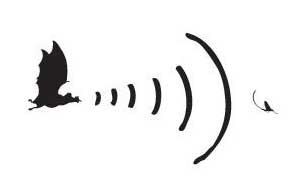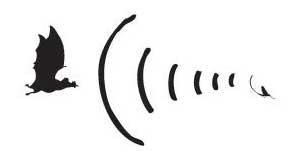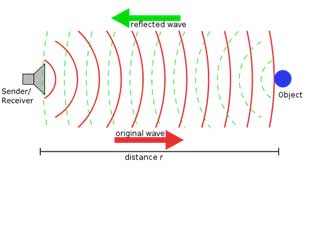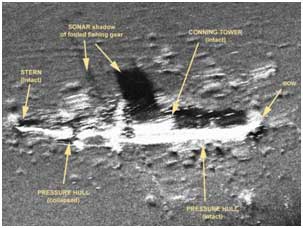Sensitive as a Bat: Navigating the World by Echoes
Most people look both ways before they cross a street. When Daniel Kish is about to cross a street, he makes a clicking noise. Most hikers look for signs to indicate which path to follow. When Kish hikes, he makes a clicking noise. When most of us get up in the middle of the night to go to the bathroom, we bump into things along the way. Kish makes a clicking noise.
Daniel Kish’s clicking is not a substitute for speech; it’s a substitute for sight.

The Townsend's Big-eared Bat is one of the species that uses echolocation to “see” object as it is navigating, or to locate prey.
Credit: US Bureau of Land Management
Like bats, dolphins, and beluga whales, Kish and a subset of other people who are blind use echolocation to map their surroundings. Kish and the others that use this technique don’t have super, extraordinary hearing abilities. However, they have learned to hear subtle differences in the echoes that are created when a sound, often a short click made by moving the tongue quickly against the roof of the mouth, is reflected back to them off of a surface.
Sound travels in waves. When you tap the stem of a wine glass with the end of a spoon, the glass vibrates. This vibration causes a compression wave to radiate out from the glass into the air, similar to how a ripple radiates outward after a rock is dropped into a pond. Eventually the wave reaches your ears and is interpreted as sound by your brain.
As shown in this retro video clip Sound, Energy, and Wave Motion by The Phoenix Learning Group, Inc, the frequency of a wave determines the pitch that we hear. Similarly, the amplitude of the wave determines its volume.
Like a ripple in a pond that hits a rock and is reflected in the opposite direction, a sound wave hitting an object (like a car, for example) is also reflected in the opposite direction. The reflection of an original noise is called an echo. In air, sound travels at about 340 meters/second, so the delay between a click and its echo depends on the distance between where the click originates and the object reflecting the sound.
 A |
 B |
| A)A bat sends out sound waves to an insect B)The sound is reflected off of the insect and back to the bat, telling the insect's location and size. Credit: US Bureau of Land Management | |
To map their surroundings, many bats make extremely high pitch sounds with their mouth or nose. Then they listen. The high pitch sounds result in echoes rich with information about the position, distance, size, shape and texture of the surrounding objects. For example, if the echo is higher pitched than the original sound, the object it is being reflected from is moving away from the source of the sound. If the echo reaches the left ear first, the object is off to the left side. If the echo is very faint, the object is small.
The sonar technology used to locate submarines under water and map ocean floors is based on similar principles. There are a few different types of sonar, but the basic physics is the same as in echolocation—a sound wave is sent out and the resulting echo provides information about the surroundings. This image of the USS O-9 was created by translating the differences in pitch and amplitude of echoes into differences in shades of gray.
 |
 |
| Schematic of a sonar system. A pulse of sound is sent underwater in a specific direction (red), and the reflected pulse is detected (green). Credit: National Oceanic and Atmospheric Administration |
Side-scan sonar image of the remains of the submarine USS O-9 (SS-70) off the Isle of Shoals, New Hampshire in more than 400 feet of water. Credit: National Oceanic and Atmospheric Administration |
Humans are constantly surrounded by noises and the echoes they create, but in most cases the echoes are not loud enough to capture our attention. However, Kish and others have shown that people who are blind or visually impaired can learn to recognize and interpret echoes in a manner sensitive enough that they can determine the location of trees, bushes, cars, and all other kinds of objects, and even distinguish between them.
Researchers at the University of Western Ontario’s Centre for Brain and Mind in London, Ontario, Canada recently made a surprising discovery. They studied two experts in echolocation, one blind from a very early age and one who became blind during his teenage years. Using MRI technology, the research group saw that echolocation experts process the echoes from their clicks using the part of the brain that processes visual information in sighted people. This was surprising because one might expect that the part of the brain that usually processes sound would be more active in during echolocation, but that wasn’t the case.
Kish’s echolocation skills enable him to be nearly as self-reliant as a sighted person when it comes to extreme situations like mountain biking and living alone in a remote cabin. An organization he founded has exposed at least 500 blind students to echolocation. However, the blind and visually impaired community has mixed thoughts about whether the benefits of learning echolocation are worth the enormous time investment it requires for many students.
Regardless, watching a person who is blind navigate using echolocation is fascinating; it looks a lot like magic. However, physics shows that it is entirely possible for humans to use echolocation to build a visual image of their surroundings.














